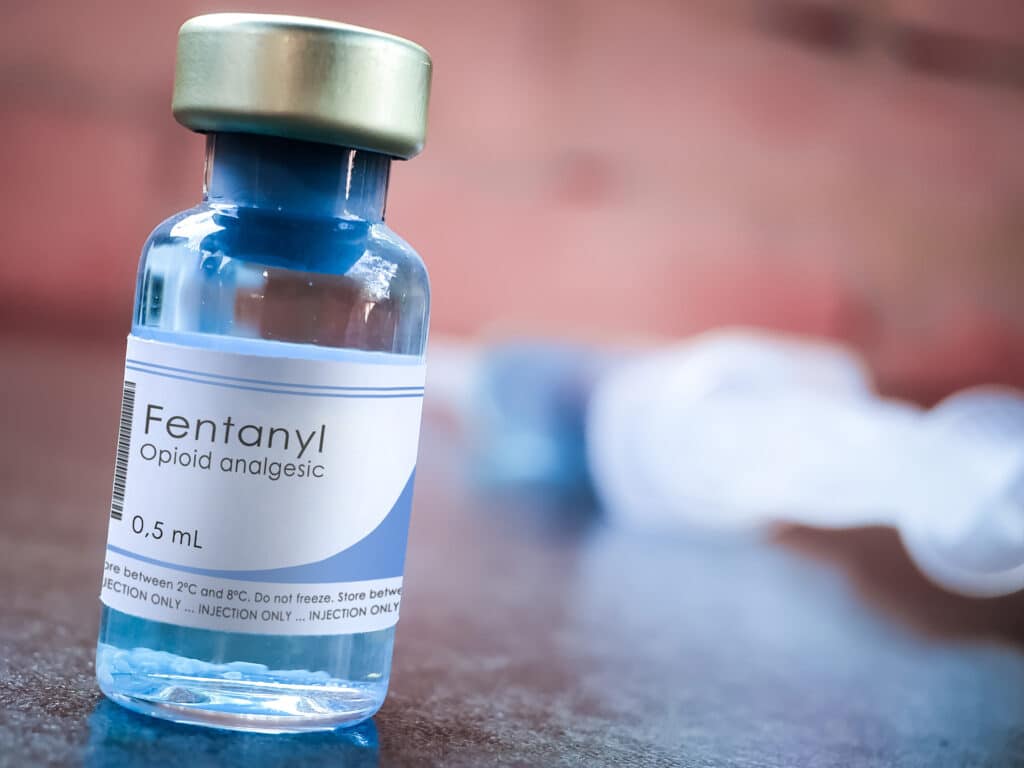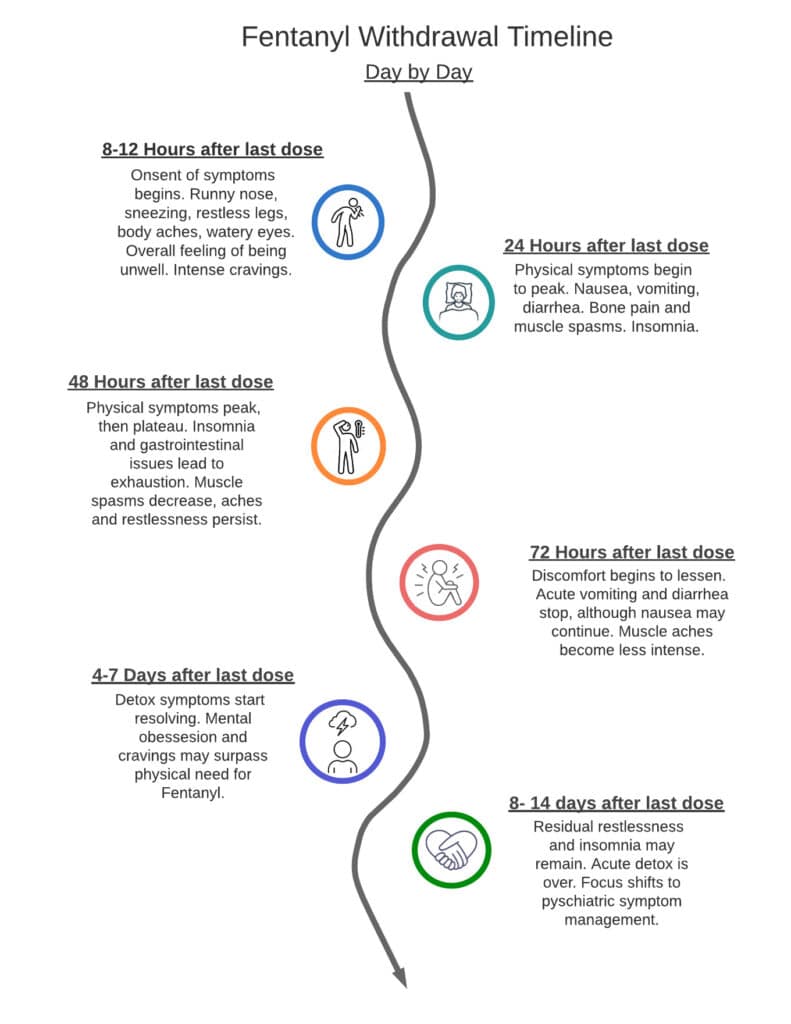How long does Fentanyl stay in your system and what is Fentanyl Rehab?
Fentanyl. The synthetic opioid drug was at the center and a major driver of the 3rd wave of opioid overdose deaths in the United States. Fentanyl prescription medication is used to treat chronic and moderate to severe pain and belongs in the same family of opioids such as morphine and oxycodone. It offers highly effective pain relief making the drug potency a high risk for tolerance, dependence and addiction. It is almost 100 times more powerful than morphine and works by binding to the opioid receptors in the brain and spinal cord, which control functions of pleasure and pain.

Polydrug use is not uncommon. The co-use of synthetic fentanyl and stimulants is currently fueling the latest overdose crisis and spreading not only in the U.S. but to other parts of the globe. Today, illicit fentanyl is continuing to rise at an alarming rate. With the latest 4th wave of the opioid epidemic, researchers are finding that the availability of illicit fentanyl and stimulants such as methamphetamines and cocaine are the driving cause of drug overdose deaths.
Overdose can be caused by taking a single powerful dose of fentanyl or taking more fentanyl while the body is still trying to process the previous dose. The dangers of the opioid crisis only continue to rise as illegal or illicitly manufactured fentanyl has proven to be even more dangerous. This is because it is cut with other unknown substances. Research has found that more than 40% of illegally manufactured fentanyl contains lethal doses of the drug along with other contaminants.

How long does Fentanyl stay in your System?
The length of time fentanyl remains active in the system is dependent on many factors. On average, it can take a typical body between 22-48 hours to process and be eliminated from the system. For long-time users and severe addicts of fentanyl, it could take the body much longer to process and remove the drug. Fentanyl’s half-life ranges anywhere from 3 hours to 12 hours. According to the National Institute of Health, research has found that up to 97% of the drug can be removed from the body following 4-5 half-lives.
Compared to other short-acting opioids, fentanyl takes longer for the body to process. The effects can last anywhere from 30 minutes and up to three days. When injected the effects begin quickly and last between 30 minutes to one hour. When snorted or smoked, the effects can last between 2-4 hours. When using the patch, the effects can last for about 72 hours. A transdermal patch slowly releases the drug over a longer period of time allowing for a more steady absorption into the bloodstream. This means the effects last longer as well as stay longer in the body. If ingested through an intranasal spray, fentanyl also produces a rapid onset of effects because it is able to enter the bloodstream quickly.
With drug tests, fentanyl can still be detected in blood for up to 72 hours after the initial dose. In urine tests, it can be detected up to 3 days after and in hair, it can be detected for up to 90 days after the initial dose.

Factors that affect the processing of Fentanyl in the body
- Age, body composition and metabolism. Younger people tend to have a faster metabolism. A faster metabolism means the body is able to process the drugs in the liver faster and eliminate the drugs more quickly. In those who have a higher body fat percentage such as women, the drugs stay in the body longer and are eliminated at a slower rate.
- Dose and frequency of drug use. Large quantities of drugs as well as frequent use of drugs can result in fentanyl lingering in the body for much longer than expected. Frequent use can cause a build-up of toxins in the body due to it not being fully eliminated and cause a backup and slow down of liver processing functions.
- Method of administration. Fentanyl can be injected, swallowed in pill form, snorted, smoked or absorbed through a patch. Each method of administration allows the drug to enter the bloodstream differently. Injecting and smoking fentanyl leads to faster absorption and elimination compared to other methods of taking fentanyl.
- Liver and Kidney functions. Fentanyl and other drugs are processed in the liver and kidneys. Users who have any preexisting complications with their liver or kidney have a more difficult time processing the drugs and can lead to a slower elimination process. This leaves fentanyl in the body for longer.
- Other medications and substances. The combination of fentanyl with other substances can slow down or hinder the elimination process of the drug in the body. Some people mix fentanyl with other drugs such as alcohol and this could be dangerous because both drugs are being processed in the liver at the same time, sending the organ functions into chaos and overdrive.
Check Your Insurance Coverage for FREE
Find out if your insurance covers addiction treatment in minutes. We accept most insurance!
Fentanyl Rehab
Because of the growing epidemic of fentanyl-driven opioid overdose, behavioral health treatment programs see the importance of catering specifically to fentanyl rehab. Fentanyl rehab and recovery includes a combination of medication-assisted treatments (MAT) as well as intensive cognitive therapies. MAT can help the user reduce drug cravings, reduce the pain of withdrawal symptoms, prevent drug relapse, and provide a stable and controlled environment for the patient as they eliminate the drug from their system. Individual and group therapies help treat any co-occurring mental health conditions that can be present alongside the addiction. This helps to address the physical symptoms along with the psychological and behavioral symptoms of fentanyl addiction.
The first step in fentanyl rehab begins with detoxing from the substance. This phase of recovery can be extremely difficult. There are a few different treatments used to help ease the uncomfortable symptoms of detox and withdrawal.
- Suboxone – This medication is a combination of buprenorphine and naloxone and is one of the most common forms of medication treatment used for opioid addiction. Buprenorphine is a partial agonist and works by binding to the opioid receptors, but only produces half the strength of the effects compared to a full opioid. Naloxone is an opioid antagonist that helps prevent the misuse of the medication and can immediately send a user into withdrawal if they use opioids. It reverses the effects of opioids.
- Methadone – Methadone is a full agonist opioid receptor that attaches to the neurotransmitter and activates its effects at a lower level to help ease withdrawal symptoms. It can also help ease cravings for the drug.
- Naltrexone – This medication is an opioid receptor antagonist that prevents fentanyl from attaching to the opioid receptors and completely blocking its effects on the body.
Cognitive and behavioral treatments are also important when treating a fentanyl addiction. Oftentimes substance addictions can trigger mental health conditions or vice versa. Because of this, it is important to treat both conditions at the same time.
Reach out to Hotel California by the Sea
We specialize in treating addiction and other co-occurring disorders, such as PTSD. Our Admissions specialists are available to walk you through the best options for treating your addiction.
Fentanyl Treatment
Hotel California by the Sea provides fentanyl rehab for clients at all levels of treatment and recovery. Our fentanyl rehab program provides drug detox, residential inpatient, partial hospitalization programming and intensive outpatient programming. As clients move through each phase of treatment, they will continue to progress in their ability to understand, accept and manage their addiction.
We provide evidence-based treatments such as CBT, DBT and EMDR therapy to help address any mental health disorders that may be present. These individual and group therapies help keep clients accountable during the treatment process as well as teach them the skills and knowledge they need in order to remain sober throughout recovery. At Hotel California by the Sea, we are committed to helping any persons struggling with fentanyl abuse and co-occurring mental health disorders, to heal and overcome their addiction.
References:
https://www.matcareclinics.com/how-long-does-fentanyl-stay-in-your-system/
https://anrclinic.com/blog/how-long-does-fentanyl-stay-in-your-system/
https://www.bicyclehealth.com/opioid-education/fentanyl/how-long-in-your-system
https://www.ncbi.nlm.nih.gov/pmc/articles/PMC8154745/
https://nida.nih.gov/research-topics/fentanyl
https://www.goodrx.com/fentanyl/how-long-does-fentanyl-stay-in-your-system
